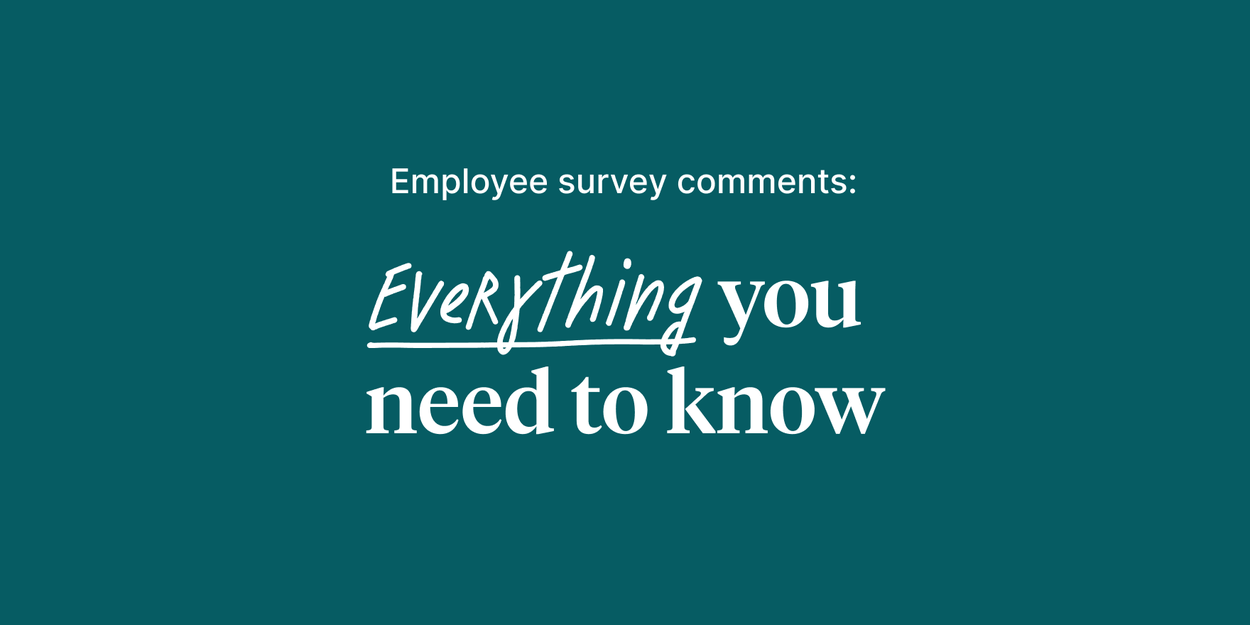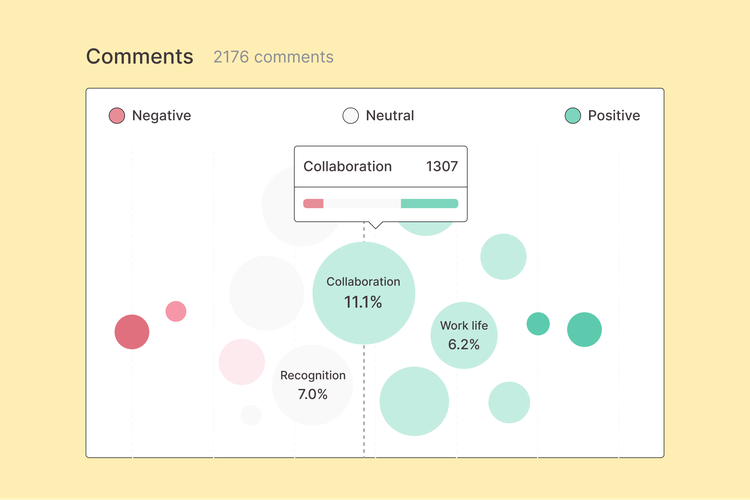
Employee survey comments: Everything you need to know (Updated 2024)

Written by

Director of People Science Research, Culture Amp

Global Senior Director of Customer People Science at Culture Amp
One of the great benefits of employee surveys is that they allow companies to collect feedback at scale. However, surveys can’t replace face-to-face conversations. Over the years, surveys have evolved to better accommodate the need for both quantitative (numbers-based) and qualitative (written) insights.
For companies using the Culture Amp platform, all employee engagement questions, even those asked on a rating scale, also collect employee comments. Using our Benchmark data, here are some statistics we’ve found when it comes to adding comments to rating items:
- About 6% of people typically add a comment to a rating question
- People are 8x more likely to leave a comment if they disagree with the question
- 7 out of 10 of the most commented items have a benchmark score under 70%
- Negative comments are twice as long as positive comments
- Collaboration is the most commented topic across industry and region
So, if the percentage of people leaving comments on rating questions is small and typically negative, do employee engagement survey comments matter?
Absolutely. We've found that open-ended questions like “What’s one thing we’re doing great here?” have much higher participation rates (around 60%).
In this guide, we’ll explain why all types of employee survey comments matter and how to interpret and take action on them. We'll also explain how you, as an employee, can write actionable survey comments to help you gain traction with leaders and improve your workplace.
Why do employee survey comments matter?
People want to have their voices heard. One look at the explosion of social media and online rating sites like Yelp can tell us that. The same holds true in the workplace. Having an employee survey process is important and demonstrates that you want feedback from employees. Giving people the ability to provide feedback in their own words is equally valuable.
People often want to justify or add context to a response, and providing them with the ability to leave comments enables them to do that. Monique Hughes, Senior Customer Success Coach at Culture Amp, says, “Not providing the ability to add comments can create a distinct source of friction in an employee survey.”

Ready to collect employee survey comments?
When and how should you review employee survey comments?
There can sometimes be a desire to read the comments first. It’s satisfying to see what people say in writing, but starting your survey analysis with employee comments can be misleading. The question remains: when is the right time to review employee survey comments?
- When reviewing employee survey data, start with your participation rate. Ensure you have enough of your organization represented to be confident in the data. See this guide for the right employee survey response rate for your company’s size.
- Take a look at your overall engagement score. If you've surveyed over time, you may also be comparing your score to historical results and other benchmarks.
- Check for outliers or significant differences. In the Culture Amp platform, we have guides that help you find the micro-cultures in your organizations – e.g., Is the Sales Department getting a result that is different from other departments? See how the Heatmap can help you find outliers.
- Use driver analysis and within Culture Amp, the focus agent, to choose key areas for action.
- Finally, once you’ve selected a focus area, use the comments to provide context to your action items. Depending on the volume of comments, you may want to quickly assign them to your themes. This will place the comments into the analytical context you've already developed.
Monique advises customers to view comments as a secondary and supplementary data source. She also encourages caution in over-interpreting comments. “Don’t use comments to decide your focus area; use them to provide additional understanding. Once you have your focus area, you can always pull out 1-2 especially illustrative comments, as an example to help humanize the data,” she says.
Don’t use comments to decide your focus area, use them to provide additional understanding. Once you have your focus area, you can always pull out 1-2 especially illustrative comments as an example to help humanize the data
Monique Hughes
Senior Customer Success Coach at Culture Amp
How to use comments to tell a story with your data
“When people fill out an employee survey, it’s a personal and sometimes vulnerable act. Hearing that aggregated data back in a detached way (as numbers-only storytelling can be) separates the person from the results,” says Myra Cannon, People Scientist at Culture Amp. Using comments to humanize the data when presenting your employee survey results can help people relate on a deeper level. For example, saying Learning & Development is at 60% doesn't resonate as well as a comment summarizing that sentiment.
Text analytics can also help you determine what people are talking about and their general emotions. The image below shows Culture Amp’s text analytics tool, with negative comments on the left and more positive comments on the right.

Lastly, sorting your questions by the number of comments on each shows you the "noisy" things within your organization. These are the things everyone is talking about. That doesn't mean you necessarily need to focus on that, but you should make a point to include that theme when sharing results to ensure people feel like their voice is heard.
A word of caution on sharing employee survey comments
Sharing employee survey results is incredibly important to building trust in the feedback process and involving everyone in taking action. However, it’s also important to ensure that people feel they can be honest when leaving comments. This is why companies should use caution when sharing employee survey comments broadly.
Comments (aka, qualitative data) are an important piece of the feedback puzzle and can help provide context and color to the more quantitative data collected via surveys. With that said, comments need to be handled with care as they tend to elicit much more of an emotional response than numeric results do, and comments tend to be heavily skewed to the negative.”
Dr. David Ostberg
Director of Cultural Enablement at Culture Amp
David recommends sharing company-level quantitative results (i.e., numeric data) with leaders, managers, and employees first and giving them time to digest the key outcomes before sharing the comments. Also, he says, “Have one or two members of the People/HR team review comments before sharing them with the company to ensure there’s nothing inappropriate or mean-spirited that calls out a specific employee or team. Feedback, including comments, should be collected in the spirit of driving positive change, and inflammatory comments toward individuals don’t help properly drive learning and growth.”
Examples of positive and negative employee survey comments
What type of comments can you expect on an employee survey? Some people like to describe their answers or get something off their chest. Others like to praise someone they work with or express gratitude to their employer.
With Culture Amp, text analytics provides a valuable way to answer the high-level question of “What are people talking about?” and “Generally, how positive or negative are people’s sentiments on a certain topic?”
Examples of positive employee survey comments
- "We continue hiring very good people for product development and all other company areas. Everyone I work with is passionate about their jobs and collaborates well with other teams."
- "My ability to relate to my managers is what makes this place great."
- "Pushing our dream and values. Good places for people to work and flexible work patterns. Plenty of activities for employees, such as Hack Day and social events. Learning development courses."
Examples of negative employee survey comments
- "I think some more attention needs to be given to help get the negative people on track instead of reprimanding the whole group when there is an issue."
- "We are growing. We could use some more permanent desk spaces for employees at HQ. There are hot desks near my team, but it's always a question when I come into the office if I have somewhere to sit near my team."
- "Policies and benefits should be front and center, not hidden away."
How to write constructive employee survey comments
Open-ended survey comments can be a mixed blessing. On the one hand, both employees and leaders benefit from well-written comments. Employees get a clearer voice on how the organization functions, potentially making their work and careers more successful. Leaders get specific guidance on ways they can better inspire and direct employees to achieve organizational goals and address the unintentional side effects of their decisions.
However, comments often vary wildly in their usefulness. Comment writing is not a skill taught in any classroom. As a result, employees often write comments that express their frustration and overstate valid criticisms without providing the information leaders need to act. In turn, leaders, especially middle managers, tend to read comments with an eye toward defending against accusations of ill intent or incompetence. As a result, even though employees are eager to share their stories and leaders hunger for more narrative feedback, many comments fail to deliver on their potential for improvement.
In the Culture Amp platform, employee comments are directly linked to specific questions making it clear which issues they are discussing. In addition, our text analytics and keyword search tools help you identify comments relevant to the issues you are considering.
The three I’s of constructive comments
The three I's of constructive comments are: Issue, Impact, and Intervention.
The Issue is the challenge or opportunity you want to identify to leaders. It can be a problem you experience or a chance to improve operations. You always want to state the issue clearly and early in a comment to:
- Make it easier to pick out your comment as relevant to the issues under consideration
- Keep the context clear if it is used in a report separate from your other comments or the original question
The Impact explains how the issue affects you, other employees, the organization, customers, or the larger community. Your impact statement illustrates how the issue impedes or advances success for the affected parties and why the organization should change its behaviors. Your impact statement should provide as many details as possible without making you identifiable.
The Intervention suggests how employees, leaders, or the organization should act differently to resolve the issue and better impact its stakeholders. Again, detail is beneficial here as it allows leaders to quickly assess if and how the intervention should be implemented.
Mad Libs for employee survey comments
You can follow the guidelines above to draft comments using your own voice, or use the Mad Libs outline below for a more structured approach.
ISSUE: I have noticed that _______________ (situation or behavior) that I believe (helps/harms) our ability to be successful with___________________ (goal).
IMPACT: Due to this issue I have seen___________________________ (situation or outcome) causing _____________ (missed goal). For example, ___________________ (specific illustration of the issue you have witnessed).
INTERVENTION: I believe that___________________ (suggestion) would be valuable. If this is done, I expect _____________________ (improved impact) and be able to _____________________ (achieved goal).
Example of a constructive survey comment
I have noticed a lack of central leadership in our office that I believe harms our ability to be successful with meeting client deadlines.
Due to this issue, I have noticed that no one is empowered to make big decisions that involve multiple practices causing us to miss client deadlines. For example, the Alpha project was three weeks late because no one in the office had the authority to approve shifting team members between high and low priority projects.
I believe that hiring a dedicated market leader would be helpful. If this is done, I expect we would allocate staff more efficiently and be able to meet client deadlines more consistently.
Start collecting employee feedback today
With an employee survey that allows people to leave comments, you're provided with richer data to take action. If you're ready to start, the People Scientists at Culture Amp are standing by to help you.

Understand your employees
Make better decisions and drive meaningful change by understanding your people.



